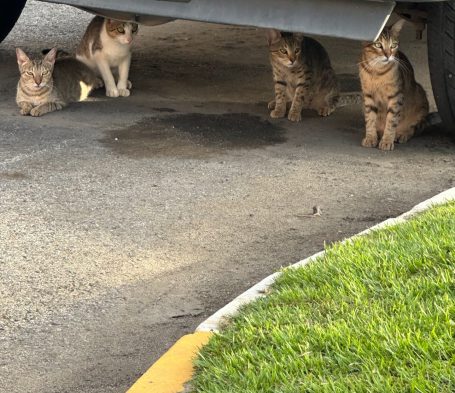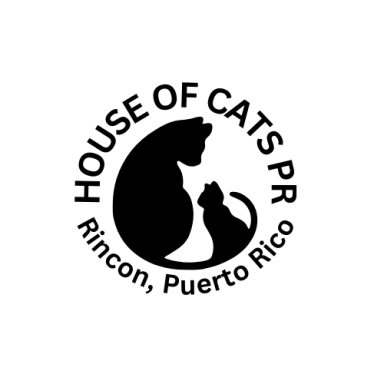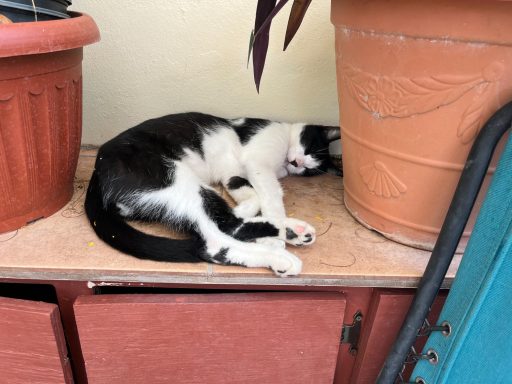TNR, TNVR- Trap, Neuter, Return (hopefully with vaccinations.)
Trap-Neuter-Vaccinate-Return (TNVR) is a humane method for managing feral cat populations. TNVR can be used to effectively manage and improve the welfare of a single feral cat or a whole cat colony. Don't forget the "ear-clipping." This is important so cats can be identified as being neutered and they won't be sent unnecessarily to the vet.
Make a veterinarian appointment before you trap a cat. Make sure a female cat does not have kittens that she is feeding.
Supplies:
- If the cat is very feral and not trusting at all, obtain humane traps suitable for trapping feral cats. The traps should open on both ends to make it easier for the vet to access the cat. Another option if the cat is somewhat friendly is to use a medium to large sized dog carrier and quietly close the door while the cat is inside eating.
- Before you trap, put a bowl of water into the trap. Make sure this bowl stays full the whole time the cat is in the trap. Prior to trapping place a blanket over the sides of the trap (cats like enclosed, dark places.) When the cat is trapped, cover the front of the trap with the blanket (this will calm the cat down.)
Trapping:
- Set up traps in locations where feral cats are frequently seen. Putting the trap near a structure that they are used to will help to make the cat more comfortable and more likely to go into the trap. Bait traps with food attractive to cats (wet cat food or tuna, sardines) by placing the food in front of the trap for a couple of days, then in the back of the trap so the cat steps on the footplate that triggers the trap door to close.
- IMPORTANT: Monitor traps regularly to ensure captured cats are not left for extended periods inside the trap. A cat could hurt itself trying to get out. Going without water and food can be dangerous for the cat's health. If the cat is in the trap overnight, place in a dry warm location.
- The day or afternoon before the vet appointment, you can feed and give water to the cat. The cat should not eat the night before surgery. With scared, terrified feral cats, do not try to open the trap - cats are amazingly quick and strong and they will escape! Try to get food into the trap through the slots; fill the bowl with water from the top or side of the trap. An isolator is a helpful tool that looks like a large pick or comb. The isolator is inserted into the top or side of a trap or cage to guide the cat into a small portion of the trap. This is important when you need to clean the trap while the cat is still in it, and for veterinarians to administer anesthesia before spay or neuter surgery. Using more than one comb can help you move the cat into the exact spot you need her and keep her in place.
Transport to Veterinary Clinic:
- Once a cat is trapped, make sure it has not been “ear-tipped.” A tipped left ear means the cat has already been spay/neutered. This cat can go into the vet to be vaccinated and checked. Transporting in the trap ensures the cat will not escape; you may want to put ties on the doors to ensure they do not open.
- Ensure careful handling and transportation to minimize stress on the cat. Cover the trap with a blanket.
Spaying/Neutering and Vaccinations:
- At the veterinary clinic, the cat will undergo spaying or neutering surgery. Feral cats should be vaccinated against common diseases, such as rabies. Ask the vet what vaccinations are important for ferals or colony cats.
- Ear Tipping: During the spaying/neutering procedure, a small portion of the cat's left ear is typically removed (ear tipping) under anesthesia. Ear tipping is a visual marker indicating that the cat has been sterilized.
Recovery and Post-Operative Care:
- Allow the cat to recover from anesthesia in a warm and quiet area. Females may need 1-2 days for recovery. Males are usually able to be set free the night of surgery. Provide food, water, and shelter as needed during the recovery period. Watch for lethargy or other signs that the cat may be in post surgical distress.
Return to Original Location:
- IMPORTANT: Release the cat in the same area to maintain its territory and social structure. Releasing a cat elsewhere is very stressful to a cat; they lose their food sources and their community of other cats.
Monitoring and Continued Care:
- If possible, provide ongoing care, such as food and shelter, to support the cats in their neighborhood or colony while preventing new litters through spay/neutering. When a feral cat is spay/neutered, they often become much nicer and are often adoptable, making really friendly pets.
Community Education:
- If possible, educate your local community about the benefits of TNR for managing feral cat populations in a humane and effective manner. Encourage responsible pet ownership (spay/neutering, vaccinations) and discourage abandonment of cats.
Feral Cat Care
The Good Thing
About Feral Cats:
Feral cats have grown up in the wild, away from a home environment, unfamiliar with humans.
However, some feral cats, especially kittens, can become more domesticated after spay/neutering.

Feral Cat Colonies:
Cats are normally domesticated animals. They do not manage well on their own in the wild or on the streets. Feral cats tend to live in colonies typically made up of females and their offspring. These cats have been distant from society for more than two generations and are afraid of humans. Studies of feral cat colonies show that one unaltered female cat can produce 3-4 litters of 4-5 kittens per litter each year of her life. If she lives 8 years, she will produce almost 100 kittens, and between her and her offspring, more than 5000 kittens will be born! Trap, Neuter, Return (TNR) is the most successful way to control these birth rates is to spay or neuter the colony cats.
The House of Cats PR (formerly the Chateaux De Gatos Sanctuary) provides volunteers educated in cat colony management. We provide food to prevent colony hunger and equipment required to employ a Trap/Neuter/Vaccinate/Return (TNVR) program. TNVR involves humanely trapping a feral cat, spay/ neutering and vaccinating the cat, then returning the cat to its outdoor “home” to live out its life. TNVR has been shown to be the most successful method to decrease feline overpopulation and feline disease and is endorsed by many well-respected animal welfare organizations. With this system of managed cat colony care, feral cats can live a long, healthy life without risk of hunger, disease or feline overpopulation.
You can help with donations of supplies such as food and traps, or donations toward spay/neutering. Spay/neutering costs $120 for males and $140 for females. Vaccinations are $70.

Cat Colony Care
Cat colony care requires dedication, resources, and often collaboration with local animal welfare organizations. The ultimate goal is to ensure the cats live healthy lives while preventing overpopulation and reducing the impact on the local environment.
Cat colony care, often referred to as community or feral cat colony management, involves the humane approach to managing and caring for a group of feral or stray cats. These cats are typically unowned, and a colony forms when they live together in a specific area, often around a consistent food source.
Key Aspects of Cat Colony Care:
Trap-Neuter- Vaccinate-Return (TNVR):
- The cornerstone of managing feral cat colonies, TNR involves humanely trapping cats, spaying or neutering them, vaccinating (often against rabies), and then returning them to their original location. This helps control the population by preventing further breeding.
Feeding and Nutrition:
- Regular feeding is crucial for the well-being of the colony. Caretakers often provide a consistent and balanced diet to ensure that cats receive proper nutrition. Feeding stations should be placed in safe, secluded areas to minimize the risk of attracting predators or complaints from the public.
Shelter:
- Providing shelter is important, especially in extreme weather conditions. Caregivers often set up shelters to protect cats from the storms, rain, and excessive heat. These shelters should be discreet and located in areas where the cats feel safe.
Monitoring and Health Care:
- Regular monitoring of the colony is essential to check for new cats that may not be spay/neutered (check for ear tipping), health issues, or signs of injury. Sick or injured cats should be trapped and taken to a veterinarian for treatment. Vaccinations and flea control are also part of ongoing care.
Socialization and Adoption:
- While many feral cats are not socialized to humans and prefer to live in the wild, kittens or less feral adults may be socialized and adopted. Caretakers work to socialize these cats and place them in permanent homes when possible.
Community Engagement:
- Working with the community is crucial to the success of a cat colony care program. This involves educating the public, addressing concerns, and working with local authorities to ensure the colony is managed humanely.
Record-Keeping:
- Keeping detailed records of each cat in the colony (including spay/neuter status, health records, and behavioral observations) helps in effective management and tracking of the colony's health and growth.
©Copyright. All rights reserved.
We need your consent to load the translations
We use a third-party service to translate the website content that may collect data about your activity. Please review the details in the privacy policy and accept the service to view the translations.




